Last week, free-speech social media hub Gab launched an AI-based image generator, Gabby. Gabby gained instant popularity and has generated hundreds of thousands of graphics since launch.
Gabby is free to use. Free users have a generous 500/month images limit. Pro users (paid members of Gab) have unlimited access.
Users can prompt Gabby with a description of the image they want to see, and even specify the art style and medium, and Gabby will attempt to interpret the input and fabricate an image (based on its training) that meets the criteria.
For instance, one can say “Old brown chihuahua sitting on wooden floor” and you will get something like this:

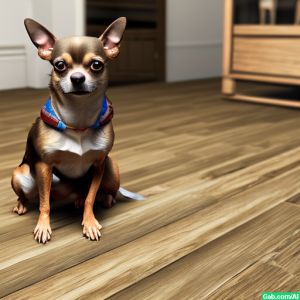
With dogs in particular, I have noticed that the AI sometimes gets confused on the hind quarters and you will see strange lumps or extra legs.
It also often has trouble with human faces and sometimes adds extraneous arms and legs onto human figures.
But, despite its weakness in some areas (still being a beta program), it is amazingly robust and deep in its knowledge and training.
For example, “Chuck Norris as a Runescape Character” correctly renders, as does “Chuck Norris dressed as Superman.”
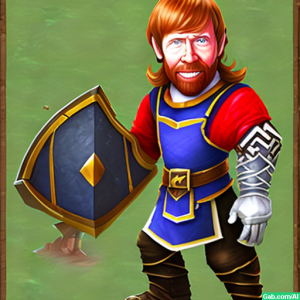

See also:
“Old man and old woman walking in a garden with Appalachian Mountains behind them”

“Adam Schiff dressed as Benedict Arnold”

“A log cabin in a field of sunflowers at dawn”
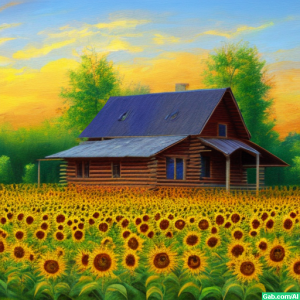
“A Christian knight with lions head standing in front of an American flag, hyperrealistic, 8k photo” gave me this:
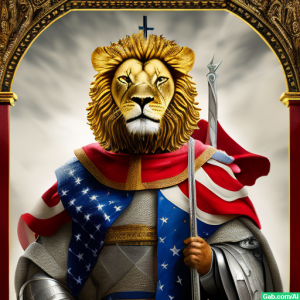
“An oil painting of children watching a nuclear explosion, Appalachian mountains, mushroom cloud,forest, hyperrealistic, detailed,4k”
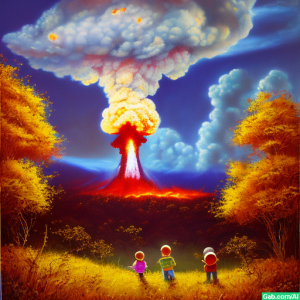
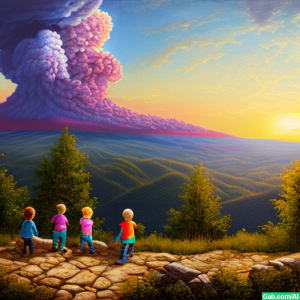
“An oil painting of a sunflower in the style of van gogh”
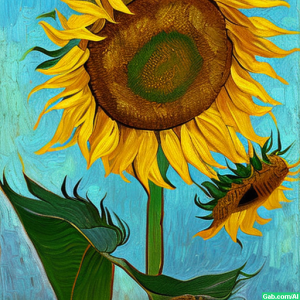

“A family reunion in 1960 at a farmhouse”

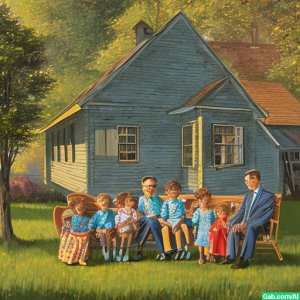
“A watercolor of a farmhouse by a river”

For more examples of how people are using this tool, see the “Gab AI Art” group on Gab.
As you can see, even in its current form, the Gabby AI has a considerable breadth of “knowledge” and is adept (with exceptions) at piecing together elements within a composition.
Although a technical masterpiece, Gabby is not without its challenges.
The launch of the tool has not only spurred excitement and considerable creativity (by the time this review is published, it will have been used to generate over 1,000,000 images), but has also raised some well-founded concerns. That critique and conversation is actually the greatest benefit to having Gabby on-line.
One user commented about a Gabby image, “It looks like something an eight-year-old did.” And, he is right. To be fair, though, about 80% of the self-proclaimed “art” I have seen in my 55 years of life has looked like something an eight-year-old with ADHD created. It is getting more and more rare to find works of art that exhibit creativity and mastery. The quality and depth of sculpture, paintings, drawings, and other media have been progressively dumbed down and our minds are being programmed to accept and even celebrate this dumbing-down of art.
We should also keep in mind that Gabby is still in beta. The quality of its output and even its ability to interpret our prompts will only increase from this point. So, if the quality of the output is a concern to you, just wait until you see what Gabby and other AI tools will be creating a year from now.
Many other users, particularly traditional artists, have taken a decidedly negative view of Gabby and AI “art” in general. They find it to be a threat to real artists, and to some extent they are right.
Just as other technologies have changed the face of art, graphical AI’s will also bring changes.
Digital drawing tools brought many changes. People began creating art on the screen, and now even on tablets and phones, with tools that let them precisely control stroke size, texture, and pressure, and which can imitate various types of media.
Digital photography tools have made it possible to make complex adjustments to photos which used to have to be done in a darkroom – or not at all.
And, yes, both of these “revolutions” have helped diminish the quality of the products when in the hands of non-artists. We have all had our fill of cheesy graphics and over-sharpened, unnaturally color-pumped photographs which surely looked cool to their creators but bring a collective groan from the artists around them.
There is no substitute for the touch of a real artist.
When the dust settles, I believe the same will apply to AI “art.” AI art in the hands of non-artists will produce mediocre results which may appeal to a wide audience and will replace the jobs of some artists. But, AI art in the hands of an artist will product fantastic art, the likes of which we can only imagine right now.
However, the dust will not settle for a very long while, as this technology is just now exploding in the public sector.
So, what do we do with Gabby?
At the very least, Gabby is a powerful educational tool.
First, we become familiar with how we will be interacting with technology in the future. Even now, actually, many of us are forced to interact with companies through their AI tools both online via chat and via voice over the phone, rather than work with a real person. It’s a frustrating, low-quality experience usually used by companies who do not value their customers and don’t find them worth a real, live, competent customer support person.
If you are on leftist extremist platforms like Facebook or Youtube, even now, AI programs are scanning your content and blocking, shadow-banning, and adding censorship labels to your content. It is a powerful control mechanism that allows them to block or limit inconvenient information and artificially pump up the narrative they prefer.
AI is the way of the future and both industry and government are relentlessly pushing in that direction. The technology will get better as the AI tools available to the public get better, and those who adopt it will have a competitive advantage over those who don’t.
These facts should drive us harder to create local connections and an honest, parallel economy to avoid being manipulated and deceived by these tools as much as possible. They should also drive us to better understand the technology, and to support those who develop the parallel tools which will be so vital to countering those which are designed to manipulate and subject us.
Second, Gabby gives us a glimpse of the power of these types of tools. The AI technology available to the general public right now is nothing compared to what other entities have had at their disposal for years. Gabby should open our eyes. We can no longer believe anything we see. They can create a photo of you shooting another human being – perhaps even a video – and even though it will be entirely fake and false, people will believe it because it looks realistic.
They can create images of soldiers mass-murdering civilians for a disinformation campaign, and it will look realistic and believable. They can fabricate photos of political opponents in compromising situations, or images of a competitor’s products failing catastrophically, or of dramatic bombing or shelling damage to buildings, or photos of dead children in a war zone – and the vast majority of people will believe it.
These photos of Greta Thunberg burning tires were generated by Gabby with the simple prompt of “Greta Thunberg burning tires”



A cursory look at them by someone who is not familiar with what this technology can do would generate severe condemnation for Greta. Maybe she deserves derision for her arrogance, ignorance, and judgmentalism – but, not for burning tires. Once you start examining the photos, you can readily see that they are likely fakes because of the graphical glitches and differences in lighting and tone between elements.
Now, consider that public sector technology runs at least ten years behind military tech or what we might call “deep state” technology. These entities have poured billions of our dollars into creating and refining tools that are far better than what we see. Imagine the photos and videos that a billion-dollar, ten-year-old, mature, and refined graphic AI can create. This type of tool can be used against us – and surely already is – by powerful players on a global scale.
By being familiar with the technology and getting a glimpse of what is possible, we can immunize ourselves against the manipulation of others. For this one reason alone, it is useful for each of us to at least take a look at the tool.
This technology will not go away. It is too much of a powerful tool for the power-brokers of the world. We need to be familiar with it and with what it can do. We need to see for ourselves why we cannot believe any photograph or video we see from now on.
AI technology is here to stay. In the right hands, it can be used as a tool to do great things. In the wrong hands, it will bring about great suffering and will be used to further enslave us. Perhaps even “the Beast” of the Book of Revelation is not a living creature at all, but an AI system.
It’s a part of our future. It will empower the government which manages us. It will run the phones we use and even monitor the phone calls we make and emails we send. It will create images and video for the evening news. It is already empowering an army of fake social media accounts designed to push the narrative of their creators.
We may not like it, but we should at least be familiar with it. That’s the real power of humble Gabby. It’s a tool all of us can play with and experiment with, to give us a glimpse of the future and a better understanding of the tools that will be (and are already) used against us.





Be First to Comment